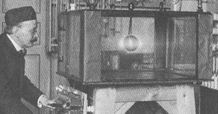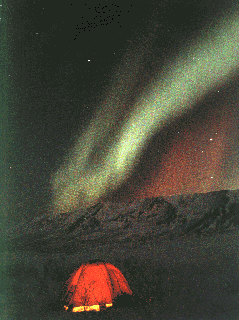|
The Norwegian physicist Kristian Birkeland (1867-1917), for instance, placed a magnetized sphere, a "terrella" representing the Earth, inside a vacuum chamber, and aimed a beam of electrons towards it. He was gratified to see that the electrons were steered by the magnetic field to the vicinity of the terrella's magnetic poles.
However, it was only in 1954 that auroral electrons were actually observed, by detectors aboard a rocket launched into the aurora by Meredith, Gottlieb and Van Allen, of Van Allen's team at the University of Iowa. Carl McIlwain, another member of that team, used a 1959 rocket experiment to identify the particles as electrons of an average energy corresponding to acceleration by 6000 volts (see high energy particles).
Nowadays scientific satellites regularly cross streams of auroral electrons and measure their properties, and aurora is also observed from the ground with video cameras and special radars.
Note on Birkeland's terrella experiment

Birkeland and his terrella.
Birkeland constructed more than one terrella experiment, including (in 1913) a much larger one in a bigger chamber, shown next to his picture on the current Norwegian 200-kroner bill. That terrella was restored in 1995 by Terje Brundtland and is now demonstrated to visitors
at the Auroral Observatory in Tromsø, Norway. For an article about that restoration, see here.
|

